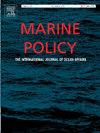新鲜沙丁鱼价值链中的不对称价格波动传导:以西班牙为例
IF 3.5
2区 社会学
Q2 ENVIRONMENTAL STUDIES
引用次数: 0
摘要
本文研究了西班牙新鲜沙丁鱼(Sardina pilchardus)价值链上价格波动的传导。使用非对称多元GARCH模型检查第一手销售、批发和零售市场的价格,发现零售市场表现出最低的波动性。因此,只有一小部分的波动从一手销售和批发市场转移到消费者。此外,在新鲜沙丁鱼价值链上的价格波动传递中发现了不对称性。这表明信息并不是在供应链上即时传递的,这表明市场效率并不完美。此外,批发市场似乎发挥了市场力量,导致价格形成不透明和潜在的反竞争行为。为了减少价格波动,可以考虑几项政策建议。这些措施包括促进有利可图的沙丁鱼水产养殖,以稳定供应,尽管面临技术挑战,并通过改进监管和更透明的个人可转让配额制度实施可持续渔业管理做法,特别是在Cádiz湾。通过改进可追溯性和简化供应链来提高市场透明度,可能会导致更具竞争力的市场,减少第一手销售的波动性。这种波动加剧了迅速耗尽配额的竞争,导致价格下降和渔民收入减少。最后,至关重要的是要考虑外部因素,如在线销售平台、气候变化和小型远洋物种的招募变化,如何影响鱼类登陆。确定价格波动的原因和传导机制可以支持有针对性的管理和透明度干预措施,以稳定收入和确保公平竞争,使消费者和渔民都受益。本文章由计算机程序翻译,如有差异,请以英文原文为准。
Asymmetric price volatility transmission in the fresh sardine value chain: The case of Spain
This paper investigates the transmission of price volatility along the Spanish fresh sardine (Sardina pilchardus) value chain. Examining prices from the first-hand sale, wholesale, and retail markets using an asymmetric multivariate GARCH model reveals the retail market exhibits the lowest volatility. Therefore, only a small portion of the volatility from the first-hand sale and wholesale markets is transferred to consumers. Additionally, asymmetries are identified in the transmission of price volatility along the fresh sardine value chain. These suggest that information is not instantaneously transmitted along the supply chain, indicating imperfect market efficiency. Additionally, the wholesale market seems to exert market power, leading to less transparent price formation and potential anti-competitive practices. To reduce price volatility, several policy recommendations can be considered. These include promoting profitable sardine aquaculture to stabilise supply despite technological challenges and implementing sustainable fisheries management practices with improved regulation and more transparent individual transferable quota systems, particularly in the Gulf of Cádiz. Greater market transparency through improved traceability and a simplified supply chain may lead to a more competitive market, reducing volatility in first-hand sales. This volatility fuels the competitive race to exhaust quotas rapidly, resulting in lower prices and reduced fishers’ income. Lastly, it is crucial to consider how external factors, such as online sales platforms, climate change, and recruitment variability in small pelagic species, affect fish landings. Identifying the causes and transmission mechanisms of price volatility can support targeted management and transparency interventions to stabilise revenues and ensure fair competition, benefiting both consumers and fishers.
求助全文
通过发布文献求助,成功后即可免费获取论文全文。
去求助
来源期刊

Marine Policy
Multiple-
CiteScore
7.60
自引率
13.20%
发文量
428
期刊介绍:
Marine Policy is the leading journal of ocean policy studies. It offers researchers, analysts and policy makers a unique combination of analyses in the principal social science disciplines relevant to the formulation of marine policy. Major articles are contributed by specialists in marine affairs, including marine economists and marine resource managers, political scientists, marine scientists, international lawyers, geographers and anthropologists. Drawing on their expertise and research, the journal covers: international, regional and national marine policies; institutional arrangements for the management and regulation of marine activities, including fisheries and shipping; conflict resolution; marine pollution and environment; conservation and use of marine resources. Regular features of Marine Policy include research reports, conference reports and reports on current developments to keep readers up-to-date with the latest developments and research in ocean affairs.
 求助内容:
求助内容: 应助结果提醒方式:
应助结果提醒方式:


